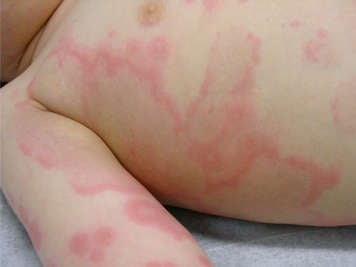什麼是蕁麻疹?
蕁麻疹是長在皮膚表面、令人感覺瘙癢的紅色腫塊。蕁麻疹可能出現在孩子體表任何部位,且腫塊大小不一。

蕁麻疹的徵兆和症狀
蕁麻疹有急性和慢性之分。急性蕁麻疹發病突然,但僅持續數小時或數天。慢性蕁麻疹至少會持續六周,有時甚至可持續數月或數年。
蕁麻疹可能具有以下性狀:
- 皮膚表面隆起的若干紅色腫塊或皮疹,大小不一(從幾毫米到幾釐米不等)
- 大面積的單個腫塊或皮疹
- 聚集在某一區域的皮疹,同時消退後又同時復發
蕁麻疹患兒還可能出現以下症狀:
- 劇烈瘙癢
- 腫塊區域有灼燒或刺痛感
蕁麻疹的發病原因是什麼?
蕁麻疹是由皮炎引起的。大多數情況下,急性蕁麻疹通常與病毒或某些食物、藥物過敏症有關。蕁麻疹最常見的過敏誘因有:
- 藥物
- 食物(例如 貝類、魚、堅果、蛋、奶以及食品添加劑)
- 其他過敏原,例如動物皮屑、昆蟲叮咬或花粉
蕁麻疹也可能是發生全身性過敏反應這一有致死風險的嚴重過敏反應的跡象。 有些時候,您也許無法確定孩子為什麼會出現蕁麻疹。
如何幫助蕁麻疹患兒
如果孩子反復出現蕁麻疹,請留意每次發病是否有共同因素,例如某種食物、藥物或某一場所。如果您知道哪些因素可能引發蕁麻疹,請在下一次就診時告知孩子的醫生。
如果孩子患了蕁麻疹,可讓其口服抗組胺藥物,以緩解症狀。孩子的醫生或藥劑師可提供具體藥品建議。諮詢孩子的醫生,瞭解皮疹消退後還需服用多久抗組胺藥物。
醫生如何幫助蕁麻疹患兒
如果孩子的蕁麻疹已持續六周以上,請與醫生預約就診。醫生可能會將孩子轉介給過敏症專科醫師。該專科醫師或許能夠確認蕁麻疹的觸發因素,或開具其他有助於緩解症狀的處方藥。不過,慢性蕁麻疹的致病原因通常無法確定。
何時尋求醫療援助
如果蕁麻疹患兒同時出現以下任何跡象或症狀,請帶孩子就近前往醫院急診部,或撥打911。
- 呼吸困難
- 面部、喉嚨、唇舌腫脹
- 血壓迅速降低
- 暈眩
- 暈倒或意識喪失
- 喉頭髮緊
- 聲音嘶啞(突然出現)
- 頭暈
這些都是全身性過敏反應的跡象和症狀。即使您已經給孩子注射了腎上腺素以控制全身性過敏反應,仍應該帶孩子去醫院,因為症狀可能會在注射腎上腺素的數小時後復發。